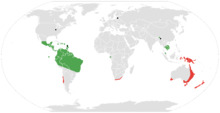| Peripatidae | |
|---|---|
.jpg) | |
| Scientific classification | |
| Kingdom: | Animalia |
| Phylum: | Onychophora |
| Class: | Udeonychophora |
| Order: | Euonychophora |
| Family: | Peripatidae Evans, 1901 |
| Genera | |
| See text | |
 | |
| Global range of Onychophora extant Peripatidae fossils | |
Peripatidae is a family of velvet worms.[1] The oldest putative representatives of the family herald from Burmese amber dated to the mid-Cretaceous, around 100 Ma, with representatives from Dominican and Baltic amber attesting to a broader distribution in the Palaeogene / Neogene; molecular variability suggests that the family's crown group may have arisen in the early Mesozoic.[2]
Description
The Peripatidae exhibit a range of derivative features. They are longer, on average, than the Peripatopsidae and also have more leg pairs, numbering between 22 and 43—the gonopore is always between the penultimate pair. There are no oviparous species—the overwhelming majority are viviparous. The females of many viviparous species develop a placenta with which to provide the growing embryo with nutrients.
Distribution
The Peripatidae are restricted to the tropical and subtropical zones; in particular, they inhabit Central America, northern South America, Gabon, Northeast India, and Southeast Asia.[3]
Genera
The family consists of the following genera:
- Cerradopatus Oliveira et al., 2015
- †Cretoperipatus Engel & Grimaldi, 2002
- Eoperipatus Evans, 1901
- Epiperipatus Clark, 1913
- Heteroperipatus Zilch, 1954
- Macroperipatus Clark, 1913
- Mesoperipatus (Bouvier, 1898)
- Mongeperipatus Barquero-González et. al., 2020[4]
- Oroperipatus Cockerell, 1908
- Peripatus Guilding, 1826
- Plicatoperipatus (Grabham & Cockerell, 1892)
- Principapillatus Oliveira et al., 2013
- Speleoperipatus Peck, 1975
- Typhloperipatus Kemp, 1913
References
- ^ Oliveira, I.; Hering, L. & Mayer, G. "Updated Onychophora checklist". Onychophora Website. Retrieved 24 November 2016.
- ^ Murienne, J.; Daniels, S. R.; Buckley, T. R.; Mayer, G.; Giribet, G. (2013). "A living fossil tale of Pangaean biogeography". Proceedings of the Royal Society B: Biological Sciences. 281 (1775): 20132648. doi:10.1098/rspb.2013.2648. PMC 3866409. PMID 24285200.
- ^ Oliveira, I. S.; Read, V. M. S. J.; Mayer, G. (2012). "A world checklist of Onychophora (velvet worms), with notes on nomenclature and status of names". ZooKeys. 211: 1–70. doi:10.3897/zookeys.211.3463. PMC 3426840. PMID 22930648.
- ^ Barquero-González, Sánchez-Vargas, Morera (2020). "A new giant velvet worm from Costa Rica suggests absence of the genus Peripatus (Onychophora: Peripatidae) in Central America". Revista de Biología Tropical. 68: 300–320.